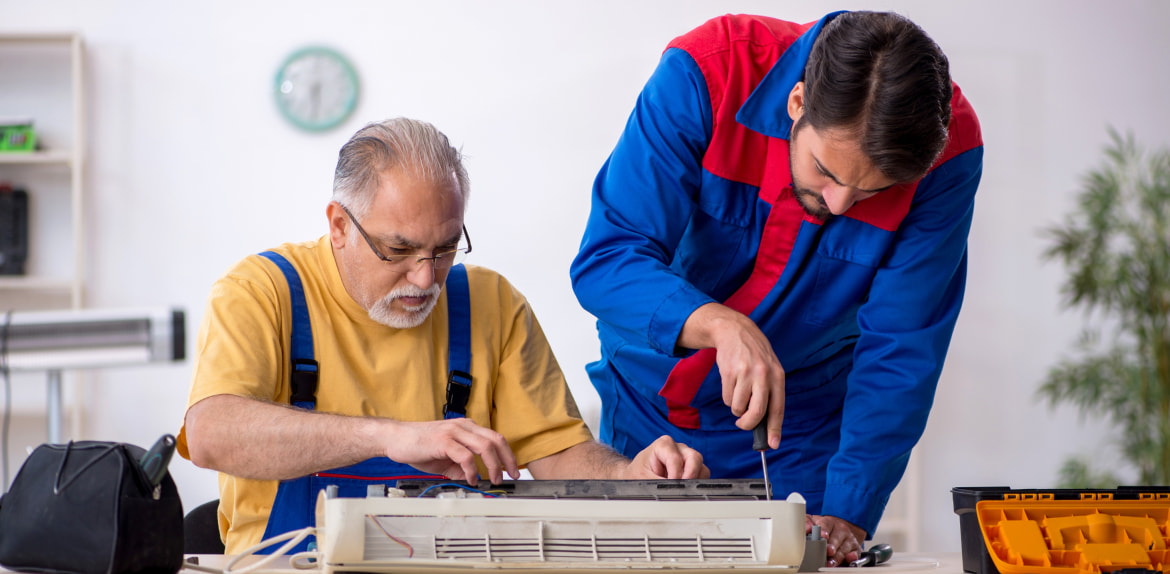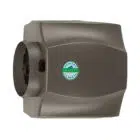
Table of Contents
At HVAC Service Solutions, we know how essential a well-functioning central AC system is, especially during those scorching hot months. To help you keep your cool and save on energy bills, we’ve put together this handy guide on the easy steps to detect central AC problems effortlessly.
Why Regular AC Maintenance Matters

Regular AC maintenance is like a spa day for your cooling system. It helps it perform at its best, ensuring comfort and energy efficiency. But why does it matter so much?
Your AC works hard, and over time, it accumulates dust and grime. Clogged filters and dirty coils make it work even harder, increasing energy consumption and the risk of breakdowns. This is where regular maintenance steps in, keeping your AC clean, efficient, and problem-free. Incorporating regular AC maintenance into your air conditioner maintenance plan is a wise investment in your home’s comfort and energy efficiency.
Check out the detailed information about our convenient air conditioner maintenance plans in Canada via the link below.
The Importance of Early Problem Detection

Imagine you’re driving a car, and you hear a strange noise from the engine. You wouldn’t wait for the car to break down before addressing it, right? The same goes for your central AC.
Early problem detection is your best friend when it comes to AC care. It can prevent minor issues from turning into costly repairs and extend the lifespan of your cooling system. Let’s dive deeper into why addressing the AC issues on time is so important.
- Avoid Costly Repairs: Detecting issues early prevents minor problems from snowballing into expensive repairs.
Extend AC Lifespan: Timely detection and maintenance significantly increase your AC’s lifespan. - Improve Energy Efficiency: Early detection keeps your AC running efficiently, reducing energy bills.
Prevent Health Hazards: Detecting issues like mold growth or refrigerant leaks early protects your family’s health. - Preserve Indoor Air Quality: Timely detection ensures your AC continues filtering out allergens and pollutants.
- Prevent Property Damage: Detecting issues early safeguards your home from potential damage.
- Reduce Emergencies: Early detection prevents AC breakdowns on sweltering days.
By addressing issues and repairing AC proactively, you can enjoy consistent cooling comfort, lower costs, and peace of mind throughout the summer months. Reach out to HVAC Service Solutions, and we will promptly eliminate the issue before it turns into a major problem.
10 Easy Steps to Detect Central AC Problems

Now, it’s time to roll up your sleeves and get hands-on with your central AC. We’ve broken down the process into ten simple steps to help you effortlessly identify common issues before they turn into major headaches. Let’s consider them more specifically.
Step 1: Check the Air Filters
Your AC’s air filters are the unsung heroes of your indoor air quality. Over time, they collect dust, pollen, and debris, which can obstruct airflow and make your AC less efficient. Here’s how to keep them in top shape:
How-to: Locate your air filters (usually in the return air duct) and remove them. Hold them up to the light – if you can’t see through, it’s time for a replacement. Clean or replace filters every one to three months, depending on usage and filter type.
Step 2: Inspect the Thermostat
The thermostat is your AC’s brain, and it needs to be sharp to maintain a comfortable environment. Ensure it’s in sync with your needs.
How-to: Check for accurate temperature readings and make sure the thermostat is level. Calibrate it if necessary or consider upgrading to a programmable thermostat for enhanced control. Additionally, change the thermostat batteries annually to prevent erratic behavior.
Step 3: Listen for Unusual Noises
Your AC should hum quietly in the background. Any strange noises should grab your attention.
How-to: Listen for hissing, banging, or grinding sounds. Hissing might indicate a refrigerant leak, banging could point to a loose or damaged component, and grinding may suggest worn-out bearings. If you hear any of these noises, it’s time to call a professional technician.
Step 4: Monitor Cooling Efficiency
Efficient cooling ensures your comfort and lowers energy bills. Keep an eye on how your AC performs.
How-to: Measure the time it takes for your AC to cool your home. If it takes longer than usual or struggles to maintain the desired temperature, it could be due to issues like a dirty evaporator coil, low refrigerant, or ductwork problems. Address these concerns promptly to restore efficiency.
Step 5: Check for Airflow Issues
Proper airflow is vital for effective cooling. Ensure your AC isn’t gasping for breath.
How-to: Ensure that all vents and registers are open and unobstructed. If some rooms are significantly warmer or cooler than others, you may have an airflow problem caused by dirty ducts, a malfunctioning blower, or improperly balanced ductwork. Consult a professional technician to diagnose and rectify these issues.
Step 6: Inspect the Outdoor Unit
The outdoor unit, or condenser, is your AC’s workhorse. It should be in top condition to do its job well.
How-to: Visually inspect the condenser for damage or debris buildup. Clear away any leaves or debris to maintain optimal airflow. Additionally, ensure there’s at least two feet of clearance around the unit to allow for proper ventilation. Trim any nearby vegetation that might obstruct airflow.
Step 7: Investigate Leaks
Leaks are a red flag. Don’t let them linger.
How-to: Look for water pooling around your indoor unit or refrigerant lines. Water leaks can indicate issues with your AC’s condensate drainage system, while refrigerant leaks are a serious concern that requires immediate professional attention. Address water leaks by clearing clogged drain lines or replacing damaged drain pans.
Step 8: Assess Strange Smells
Your AC should never be the source of peculiar odors.
How-to: If you notice musty, moldy, or burning smells, it’s time to investigate. These odors could be due to mold growth within your system’s components or electrical problems. In either case, contact a professional technician to inspect and resolve the issue to maintain indoor air quality.
Step 9: Monitor Cycling Patterns
Your AC’s cycling pattern should be like a steady heartbeat, not erratic.
How-to: Keep an eye on how often your AC turns on and off. Frequent or erratic cycling can be a sign of compressor problems, thermostat issues, or improper refrigerant levels. A professional technician can diagnose the underlying cause and restore proper cycling.
Step 10: Keep an Eye on Energy Bills
Your energy bills provide insights into your AC’s performance.
How-to: Compare your current energy bills to previous months or years. If you notice a significant increase without a change in usage habits, your AC may be running inefficiently. This could be due to various factors, including refrigerant leaks, worn-out components, or dirty coils. Seek professional assistance to optimize your AC’s energy efficiency.
Feel like it’s time to replace your AC system. Find out how much it will cost in our previous article via the link below.
https://thehvacservice.ca/what-is-the-cost-of-air-conditioning-installation/
When to Call for Professional Air Conditioner Repair

Opting for professional HVAC assistance over self-repair is a wise decision for several reasons. HVAC technicians possess the necessary expertise to accurately diagnose and fix AC problems, ensuring efficiency and safety. Attempting DIY repairs can not only be time-consuming but also risky when dealing with electrical components and refrigerants. Furthermore, professional service helps preserve your AC’s warranty, guaranteeing reliable and long-lasting results.
Now, let’s consider specific scenarios when it’s crucial to call for professional air conditioner repair:
Refrigerant Leaks: If you suspect a refrigerant leak, it’s imperative to call a professional. Refrigerants are harmful when inhaled, and fixing leaks requires specialized equipment and expertise.
Electrical Problems: Issues with the electrical components of your AC system can be dangerous. Leave troubleshooting and repairs to licensed electricians or HVAC technicians.
Compressor Failure: The compressor is the heart of your AC, and its replacement or repair is a job for professionals due to its complexity.
Frozen Coils: Frozen evaporator or condenser coils indicate a problem that could range from low refrigerant levels to airflow issues. Professionals can diagnose the underlying cause and address it effectively.
Ductwork Problems: If you suspect duct leaks, blockages, or poor insulation, HVAC experts can conduct thorough inspections, make necessary repairs, and provide a duct cleaning.
System Replacement: When your AC has reached the end of its lifespan or multiple major components have failed, it’s time for a new system. HVAC professionals can recommend and install the right replacement.
At HVAC Service Solutions, we understand the intricacies of central AC systems, and our team of certified technicians is dedicated to keeping your home comfortable year-round. When it comes to repair AC in Canada, you can trust us to diagnose problems accurately and provide effective solutions.
Conclusion
Detecting AC issues early is the key to ensuring uninterrupted cooling comfort, cost savings, and peace of mind. By following the ten easy steps outlined in this guide, you’ve empowered yourself to be proactive in maintaining your AC system.
Expert technicians at HVAC Service Solutions are ready to tackle any AC problem, from the smallest hiccups to major malfunctions. With years of experience and a commitment to excellence, we’ll ensure your AC system operates at peak efficiency, providing you with the cool, refreshing relief you deserve. Don’t hesitate to reach out to us for a professional air conditioner repair in Canada; we’re always just a call away.
Share



















